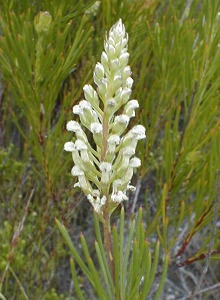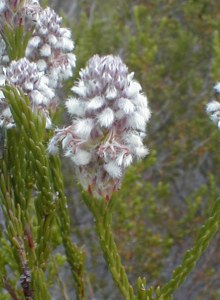
Home
Mission
Overview of Project
Project Staff
Sponsors
Achievements
Checking, Illustrations
Upcoming Activities
Id and Species Lists
Protea Information
Protea Gallery
Growing Proteas
Interim Dist. Maps
Publications
Afrikaanse Inligting
![]()
Unispoons - Spatallas
Fine-leaf Unispoon - Spatalla barbigera
 |
Habit: An erect rounded shrub up to 0.8m
tall Fire survival: Killed, only seeds survive Sexual system: Both sexes in each flower Flowers: May - November Pollinator: Insects Fruit: Released 2 months after flowering Seed dispersal: Ants Seed storage: Underground in ants nests Rarity status: Rare, scattered clumps containing a few plants Habitat: Varied, 400 - 620m Distribution: Eastern Langeberg to Outeniqua Mountains and central Swartberg |
Shiny Unispoon - Spatalla colorata
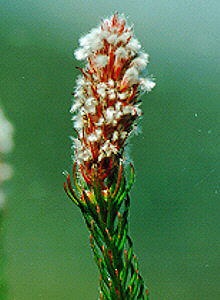 |
Habit: Erect shrub up to 0.8m tall Fire survival: Killed, only seeds survive Sexual system: Both sexes in each flower Flowers: July - November Pollinator: Insects Fruit: Released 2 months after flowering Seed dispersal: Ants Seed storage: Underground in ants nests Rarity status: Rare, scattered plants only Habitat: Cool, southern slopes, 900 - 1400m Distribution: Riviersonderend Mountains to central Langeberg |
White-stalked Unispoon - Spatalla curvifolia
|
Habit:
Rounded shrub to 0.8m tall |
Ericoid Unispoon - Spatalla ericoides
|
Habit:
An erect rounded shrub to 0.8m tall |
Pink-Stalked Unispoon - Spatalla longifolia
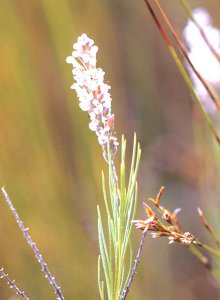 |
Habit: Erect shrub up to 1m tall Fire survival: Killed, only seeds survive Sexual system: Both sexes in each flower Flowers: August - November Pollinator: Insects Fruit: Released 2 months after flowering Seed dispersal: Ants Seed storage: Underground in ants nests Rarity status: Rare, found as solitary plants Habitat: Rocky slopes with sandstone soils, 300 - 915m Distribution: Hottentots-Holland Mountains from Franschhoek and Villiersdorp to Kleinmond |
Medusa Unispoon - Spatalla nubicola
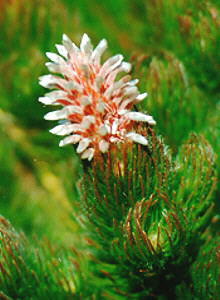 |
Habit: Erect to rounded
shrub to 1.5m tall Fire survival: Killed, only seeds survive Sexual system: Both sexes in each flower Flowers: September - December Pollinator: Insects Fruit: Released 2 months after flowering Seed dispersal: Ants Seed storage: Underground in ants nests Rarity status: Rare, two highly localised populations Habitat: Upper steep souther slopes, peaty soils, 1600m Distribution: Central Langeberg and Naaukrans Peak |
Woolly Unispoon - Spatalla mollis
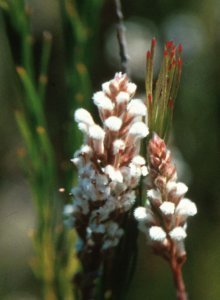 |
Habit: Rounded shrub to
0.8m tall Fire survival: Killed, only seeds survive Sexual system: Both sexes in each flower Flowers: July - December Pollinator: Insects Fruit: Released 2 months after flowering Seed dispersal: Ants Seed storage: Underground in ants nests Rarity status: Not threatened, social in scattered clumps Habitat: Seeps and river banks, peaty soils, 450-920m Distribution: Hottentott Holland Mountains from Groenland to Kleinmond |
Spike Unispoon - Spatalla parilis
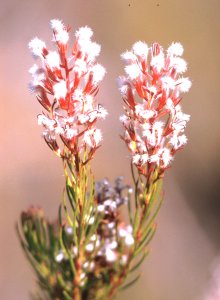 |
Habit: An erect shrub up to 1.5m tall Fire survival: Killed, only seeds survive Sexual system: Both sexes in each flower Flowers: September - December Pollinator: Insects Fruit: Released 2 months after flowering Seed dispersal: Ants Seed storage: Underground in ants nests Rarity status: Rare, but more common in the east Habitat: Cool, southern slopes in peaty soils, 300 - 1550m Distribution: Hottentots Holland to Riviersonderend Mountains top Langeberg at Garcia's Pass |
Palmiet Spoon - Spatalla prolifera
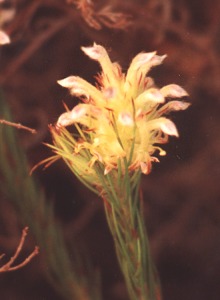 |
Habit: An erect shrub up to 1m tall Fire survival: Killed, only seeds survive Sexual system: Both sexes in each flower Flowers: September - December Pollinator: Insects Fruit: Released 2 months after flowering Seed dispersal: Ants Seed storage: Underground in ants nests Rarity status: Endangered, owing to dam building and Defence Ministry activities Habitat: Swamps, marshes and riverbanks, 50 - 460m Distribution: Hottentots Holland Mountains to Kleinmond adjacent to Palmiet and Steenbras Rivers |
Laxstalk Unispoon - Spatalla racemosa
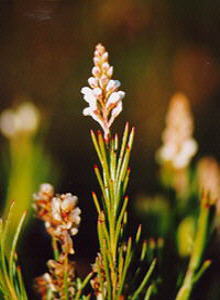 |
Habit: A small shrub up to 0.5m tall Fire survival: Killed, only seeds survive Sexual system: Both sexes in each flower Flowers: September - March Pollinator: Insects Fruit: Released after flowering Seed dispersal: Ants Seed storage: Underground in ants nests Rarity status: Not threatened, common locally Habitat: Sandstone soils, stony, sandy flats, 150-620m Distribution: Kogelberg to Groeland to Babylonstoring to Klein River Mountains and Villiersdorp |
Kink-style Unispoon - Spatalla salsoloides
 |
Habit: A semi erect shrub forming mats 1m
across up to 1m tall Fire survival: Killed, only seeds survive Sexual system: Both sexes in each flower Flowers: October - December Pollinator: Insects Fruit: Released 2 months after flowering Seed dispersal: Ants Seed storage: Underground in ants nests Rarity status: Rare, known from two populations Habitat: Rocky southern slopes 1500-1850m Distribution: Du Toit's Peak and Goudini Sneeukop above Du Toit's Kloof |
Needle-leaf Unispoon - Spatalla setacea
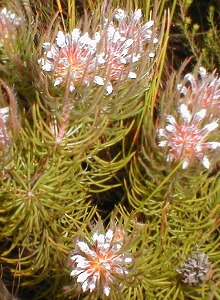 |
Habit: An erect shrub up to 1m tall Fire survival: Killed, only seeds survive Sexual system: Both sexes in each flower Flowers: October - December Pollinator: Insects Fruit: Released after flowering Seed dispersal: Ants Seed storage: Underground in ants nests Rarity status: Not threatened, occurring as scattered clumps Habitat: Peaty soils on southern slopes, 900-1250m Distribution: Slanghoek to Hottentots-Holland Mountains |
Silky Unispoon - Spatalla squamata
 |
Habit: A small shrub up to 0.5m tall Fire survival: Killed, only seeds survive Sexual system: Both sexes in each flower Flowers: August - October Pollinator: Insects Fruit: Released after flowering Seed dispersal: Ants Seed storage: Underground in ants nests Rarity status: Not threatened, occurring as scattered individuals Habitat: Sandstone sands and hills, 30-460m Distribution: Agulhas Plain |
Back Spoon Gallery
